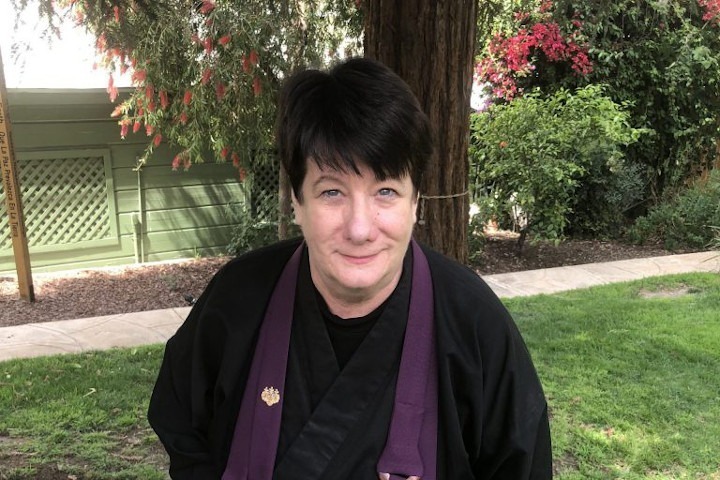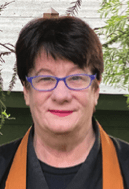
A Period of Itself
May 15, 2022
 by Katherine Daiki Senshin Griffith
by Katherine Daiki Senshin Griffith
That life does not become death is a confirmed teaching of the Buddha-dharma; for this reason, life is called the non-born.
That death does not become life is a confirmed teaching of the Buddha-dharma; therefore, death is called the non-extinguished.
Life is a period of itself.
Death is a period of itself.
For example, they are like winter and spring.
We do not think that winter becomes spring, nor do we say that spring becomes summer.
– From Dogen Zenji’s Genjokoan
It’s been two years since the Covid-19 lockdown, and the Zen Center is gradually reopening to in-person activities. Impermanence is a core Buddhist principle – but the changes occurring in our lives and across the world seem more palpable than ever.
We have lots of questions about time: When will this pandemic be just an endemic? When will we get back to normal? When will the war in Ukraine end? Is the Cold War era over? When will in-person activities be safe? Is it too late to stop the climate crisis? When will my Zen Practice lead to peace of mind?
The true nature and actual experience of time is what Dogen Zenji is examining in the above passage from the Genjokoan. Each thing has its own time, its own dharma point that can only be expressed in the present moment. But what really is the present moment? It can’t be captured. Yet how much of our time is spent in thinking of something outside this so-called moment. So much energy and dedication is needed to be present; it’s a primary focus of our practice. But this “present” is elusive. As soon as you note it, you are out of it.
Regarding the present moment, Shokaku Okumura in Understanding Genjokoan points out that it’s empty with the length of zero and just a geometrical line without any width that separates past and future. The present is the only reality we experience, and in it the entire past and the entire future are reflected. If there is no actual unit of time that is the present, then the present doesn’t exist, so time doesn’t exist. He goes on to say:
“And since everything is always changing at each present moment everything arises and perishes over and over again: each moment everything is new and fresh.”
What Dogen Zenji is pointing to is: time is being and being is time, which he later writes about in Uji or Being Time. Fundamentally, each dharma position can only be experienced in the present, ungraspable moment, which has no length. Reality unfolds within this present, ungrasp- able moment. In our zazen and lives, we sit in it, giving ourselves wholeheartedly.
It’s ironic, Zen practice emphasizes staying present, and now we find there is no present. With what mind do we grasp the ungraspable present, right now? This seemingly impossible task could be another Bodhisattva vow: Present moments are ungraspable, I vow to be present. There is no here and now, I vow to be here and now.
I can’t label “now” because it’s gone when I do. But I can be fully with my breath. In out, in out. Riffing off of Dogen Zenji, the In Breath is complete in itself, in the state of being In Breath and has its before and after. The Out Breath, is complete in itself in the state of being Out Breath and has its before and after. But do not suppose that Out Breath is after and In Breath is before. It’s just In Breath. Out Breath. Complete in themselves. I can breathe in and out with an internal: “now now,” like a soothing “there, there” – only it’s really “here, here.” Just this, just this.
Dogen Zenji is showing us a new view. When life comes, just live. When death comes, just die. Or when the last In Breath doesn’t come, just die. I’m reminded of the Catholic Hail Mary’s “Now and at the hour of our death.” Each now could be the hour of our death. Each now is a period of itself.
Seeing this, we can experience our lives fresh and new. Just seeing what’s before us. It’s amazing when we do settle, how the simplest things really pop. Whatever comes up in your life – just be it, experience it fully – then you can take the next appropriate action.
When we experience something wholeheartedly, there is no problem. This moment, this moment. Living fully in each fleeting moment without referring to the past or future. Just being one with the absolute aspect of existence.
In our ordinary view of time and cause and effect, all things eventually die. But from the absolute perspective, there are no fixed entities, no “you” that can be said to exist or perish. Only one seamless reality.
Life and Death are concepts of Time. From the relative perspective of cause and effect, we can say: “I was born, I got older, I got sick, I died.” But Dogen Zenji is referring to “no birth, no death.” Various translations of this are non-born, non-extinguished; no arising, no perishing; unborn, undying; no becoming, no non-becoming; no appearance, no disappearance. But in this one moment, without referring to past or future, there just is.
What Dogen Zenji is saying is: “life and death is Buddha’s Life.” That our life in samsara is none other than nirvana. Your life just as it is, is the life of a Buddha. On zoom. In person. Healthy. Sick. New or old job. War or peace. Aging, pandemic, injustice, confusion is the way. Practice is Enlightenment.
Though each of us experiences what is directly before us, we all perceive things differently. A five-year-old child, an angry teen, someone with dementia. All bring their causal conditions to the perception. But really, there is only that fleeting so called instant. When the sun rises and sets every day, it’s similar but always different. Watching the light change in the zendo, the shadow of the leaves hit the wall so beautifully. Moments later, the shadows are gone.
Our Zen Practice employs skillful means to remind us of the different elements of time. We’re reminded of the One Boundless Seamless dimension when we chant:
All karma ever committed by me since of old. Due to my beginningless…
When the jikido hits the clappers and we freeze, then claps again and we move, we are reminded of the aspect of time that has its independent existence, with its own before and after. Completely wholeheartedly manifested. But most of us spend quite a bit of time zig zagging in our heads, getting caught and entangled in our thoughts and distractions, missing the large view, snagged in the petty. Not seeing even the minutia as wondrous.
So, what about the past and future? It’s said that if we don’t learn from history, we are bound to repeat it. And if we don’t think ahead, we won’t be ready for when disasters come – like this pandemic. Or when and how to reopen. We can reflect on the past and learn. Reflecting on the actions of our society and ourselves, we can make better intentions for the future.
But how much of our thinking about the past or future causes us unnecessary stress, worry, anxiety or fear. Worry, anger, guilt can be helpful in small doses when paid attention to and dealt with. I worry I’m not ready, so I pre- pare. I fear getting sick, so I wear a mask. I regret having hurt someone, so I apologize. I’m confused, so I seek clarification. But if stressful states of mind linger, it can be a sign that something isn’t being faced. It’s extra, and you’re not with what is going on in the present.
A way I test my mind state when I’m stressed is I ask myself “What would it be like if the project were done?” or “if I were on vacation?” What would it feel like to be complete right now just as is? Wholeheartedly at one with this period in itself. How can this new way of looking inform our lives? I invite us all to see for ourselves what it’s like to continually be with each period in itself, and experience what T.S. Eliot describes:
“At the still point of the turning world. Neither flesh nor fleshless; Neither from nor towards; at the still point, there the dance is, But neither arrest nor movement. And do not call it fixity, Where past and future are gathered. Neither movement from nor towards,
Neither ascent nor decline. Except for the point, the still point, There would be no dance, and there is only the dance.”
Sensei Daiki Senshin was installed as the new Head Teacher on April 10.
